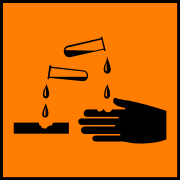|
Titration is a chemical technique used for quantitat¡ve analysis, i.e. finding the concentration of unknown solutions. By extension it can also be used for many other kinds of analysis. |
|
Experimental details
Titration is the experimental method of determining a solution of unknown concentration by the controlled addition of some reactant that, either on its own, or in conjunction with a third compound (the indicator), shows a visible change when the reaction is complete and the two compounds have reacted in stoichiometric quantities.
The apparatus
Pipette, burette, volumetric flasks, conical flasks, white tile, clamp stand.
|
|
The procedure used for titration is almost always the same, with the occasional modification depending on circumstances.
- A solution of known concentration is accurately prepared.
- A 25 ml sample of the unknown solution is pipetted accurately into a conical flask. The white tile is placed under the flask (this is to make any colour changes more obvious)
- A few drops of a suitable indicator is added.
- The reagent of known concentration is run from a burette a little at a time into the conical flask until the indicator permanently changes colour (the end, or equivalence point).
- The procedure is repeated until results of within 0.1 ml of reagent added are obtained (concordant results).
The choice of indicator depends on the two reagents (see 7.83). The choice of which reagent is placed in the conical flask and which is placed in the burette is simply a matter of convenience, or the indicator colour change required.
Primary standards
These are compounds that can be used to make up accurate solutions, which are then in turn used to standardise, or determine, other solutions. A primary standard must have the following characteristics.
- Be available in a highly pure form.
- Be soluble
- Be reactive
- Not be affected by the environment
- Have a high relative mass
It is important to know that when you weigh out a quantity of the primary standard that you are only weighing out the primary standard. Hence #1 above. The solution prepared must not change appreciably over time, hence #4 above. The higher the relative mass the lower the inaccuracy of any weighing due to balance tolerances.
For example if a 0.1 M solution is required of a standard with a relative mass of 60, then to make up a 250 cm3 solution requires 0.1 x 60 x 0.25 = 1.5 g. If the tolerance of a 2 d.p. balance is ± 0.005, this represents an inaccuracy of 0.005/1.5 x 100 % = 0.33%.
However if the relative mass of the primary standard is 180, then 4.5 g is needed to prepare 250 cm3 of 0.1 M solution. The inaccuracy due to the balance is now only 0.005/4.5 x 100% = 0.11%.
Recording results
It is essential that ALL data be recorded as it is collected. This should be tabulated for easy understanding, and include inaccuracies and units. Titration is repeated until results that are within 0.1 ml are obtained. These are called concordant results. The average of the concordant results is used in calculations.
Example results table
| Burette readings / cm3 ± 0.05 |
1st titre
|
2nd titre
|
3rd titre
|
|---|---|---|---|
| Final reading |
24.20
|
23.15
|
24.20
|
| Initial reading |
00.00
|
00.00
|
00.05
|
| total volume added |
24.20
|
23.15
|
23.15
|
| average of concordant results |
23.17 ± 0.1
|
||
Theory of acid-base titration
The amount (in moles) of the known reagent is easily calculated from the molarity and the volume.
| Moles = molarity x volume (litres) |
A titration experiment seeks to identify the exact volume of a reagent needed for neutralisation. From this volume, the unknown molarity may be calculated, by considering the stoichiometric relationship between the two reagents (the acid and the base)
|
Example: Calculate the concentration of an unknown sodium hydroxide solution, if 20 cm3 of 0.12 mol dm-3 hydrochloric acid is needed to exactly neutralise 25 cm3 of the sodium hydroxide solution. From the equation for the reaction:
1 mole of HCl completely neutralises 1 mole of NaOH moles of NaOH = moles of HCl
From the experiment data:
|
Titration calculations are marginally complicated by reagents (acids and bases) that do not react in a 1:1 ratio. These may be approached in exactly the same way, only taking into account the stoichiometric mole ratios.
|
Example: Calculate the concentration of an unknown sodium hydroxide solution, if 20 cm3 of 0.08 mol dm-3 sulfuric acid is needed to exactly neutralise 25 cm3 of the sodium hydroxide solution. From the equation for the reaction:
1 mole of H2SO4 completely neutralises 2 moles of NaOH i.e. there must be twice as many moles of NaOH at the equivalence point. moles of NaOH = 2 x moles of H2SO4
From the experiment data:
|
Clearly, it is important to identify and write out the equation for the reaction before proceding with the calculations.


